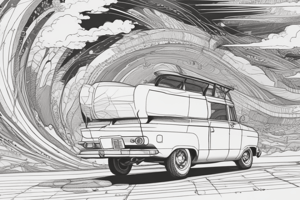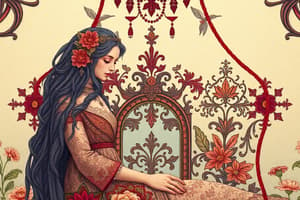Podcast
Questions and Answers
Which of the following is NOT one of the 7 elements of art?
Which of the following is NOT one of the 7 elements of art?
- Emotion (correct)
- Shape
- Color
- Line
Curved lines suggest movement and instability.
Curved lines suggest movement and instability.
False (B)
A shape is a flat, enclosed area created by ______ or color changes.
A shape is a flat, enclosed area created by ______ or color changes.
lines
What are the two main categories of shape?
What are the two main categories of shape?
Match the type of line with its corresponding quality:
Match the type of line with its corresponding quality:
Forms in art refer only to two-dimensional objects.
Forms in art refer only to two-dimensional objects.
What is the primary purpose of using shapes in art?
What is the primary purpose of using shapes in art?
Name one technique artists use to create the illusion of form.
Name one technique artists use to create the illusion of form.
Which color is often associated with earthiness and reliability?
Which color is often associated with earthiness and reliability?
Value refers to the color's intensity and does not affect depth in a composition.
Value refers to the color's intensity and does not affect depth in a composition.
What is the term used to describe the surface quality of an object in art?
What is the term used to describe the surface quality of an object in art?
In art, the illusion of three-dimensional space is created through __________ techniques.
In art, the illusion of three-dimensional space is created through __________ techniques.
Which of the following refers to the distance or area between objects in a work of art?
Which of the following refers to the distance or area between objects in a work of art?
Match the following elements of art with their descriptions:
Match the following elements of art with their descriptions:
What does high value in color suggest in a composition?
What does high value in color suggest in a composition?
Real texture can only be found in two-dimensional works of art.
Real texture can only be found in two-dimensional works of art.
What does hue refer to in color theory?
What does hue refer to in color theory?
Complementary colors provide harmony and are next to each other on the color wheel.
Complementary colors provide harmony and are next to each other on the color wheel.
What is the term for colors that are next to each other on the color wheel?
What is the term for colors that are next to each other on the color wheel?
A monochromatic color scheme involves variations in value of a _____ color.
A monochromatic color scheme involves variations in value of a _____ color.
Match the following terms with their correct definitions:
Match the following terms with their correct definitions:
Which of the following colors is often associated with passion and anger?
Which of the following colors is often associated with passion and anger?
The three main properties of color are hue, value, and _____ .
The three main properties of color are hue, value, and _____ .
Color psychology studies how colors affect emotions and behaviors.
Color psychology studies how colors affect emotions and behaviors.
Flashcards are hidden until you start studying
Study Notes
Line
- A line is a mark made by a moving point.
- Can be straight, curved, thick, thin, or textured.
- Used to create boundaries, define shapes, or imply movement.
- Horizontal lines suggest calmness, rest, or stability.
- Vertical lines convey strength, stability, or power.
- Diagonal lines indicate movement, action, or instability.
- Curved lines suggest grace, flow, or softness.
- Van Gogh's "Starry Night" uses swirling lines to depict dynamic movement in the sky.
Shape
- A shape is a flat, enclosed area created by lines or color changes.
- Has only height and width (2D).
- Categories of Shape:
- Geometric: Precise and regular shapes (e.g., circles, squares, triangles).
- Organic: Irregular, free-form shapes (e.g., clouds, leaves).
- Shapes are often used to create a focal point or balance a composition.
- Henri Matisse's cut-outs are known for their bold, simple shapes in abstract compositions.
Form
- Form refers to objects that are three-dimensional (height, width, and depth) or the illusion of 3D in a 2D artwork.
- Categories of Form:
- Geometric Forms: Cubes, spheres, cones (e.g., architectural structures).
- Organic Forms: Natural, irregular forms (e.g., rocks, tree trunks).
- Artists use techniques like shading and perspective to create the illusion of form in painting.
- Michelangelo's "David" is a sculpture demonstrating mastery of three-dimensional form.
Color
- Color is perceived when light hits an object and is reflected back to the eye.
- Main properties of color:
- Hue: The color itself, such as red, blue, or yellow.
- Value: The lightness or darkness of a color.
- Intensity/Saturation: The brightness or dullness of a color.
- Color Psychology: The study of how colors influence perceptions, emotions, and behaviors.
Value
- Value refers to the lightness or darkness of a color or tone.
- Essential for creating depth and contrast in a composition.
- High value: Light colors, suggesting light, openness, or brightness.
- Low value: Dark colors, suggesting darkness, mystery, or seriousness.
- Caravaggio's "Supper at Emmaus" uses the technique of "Chiaroscuro," meaning contrast in art.
Texture
- Texture refers to the surface quality of an object.
- Can be real (actual texture you can feel) or implied (suggested by the way an artist depicts something).
- Types of Texture:
- Real Texture: Found in sculptures, textiles, where the surface is physically textured (e.g., rough stone, smooth metal).
- Implied Texture: Created in paintings, drawings, photographs by using shading and detail to suggest texture (e.g., a fur coat drawn realistically).
Space
- Space refers to the distance or area around, between, and within objects in a work of art.
- Positive Space: The subject of the artwork.
- Negative Space: The background or empty areas surrounding the subject.
- Types of Space:
- Foreground, Midground, Background: Used to create depth in a 2D work.
- Perspective: Techniques like linear perspective create the illusion of three-dimensional space on a flat surface.
Studying That Suits You
Use AI to generate personalized quizzes and flashcards to suit your learning preferences.




